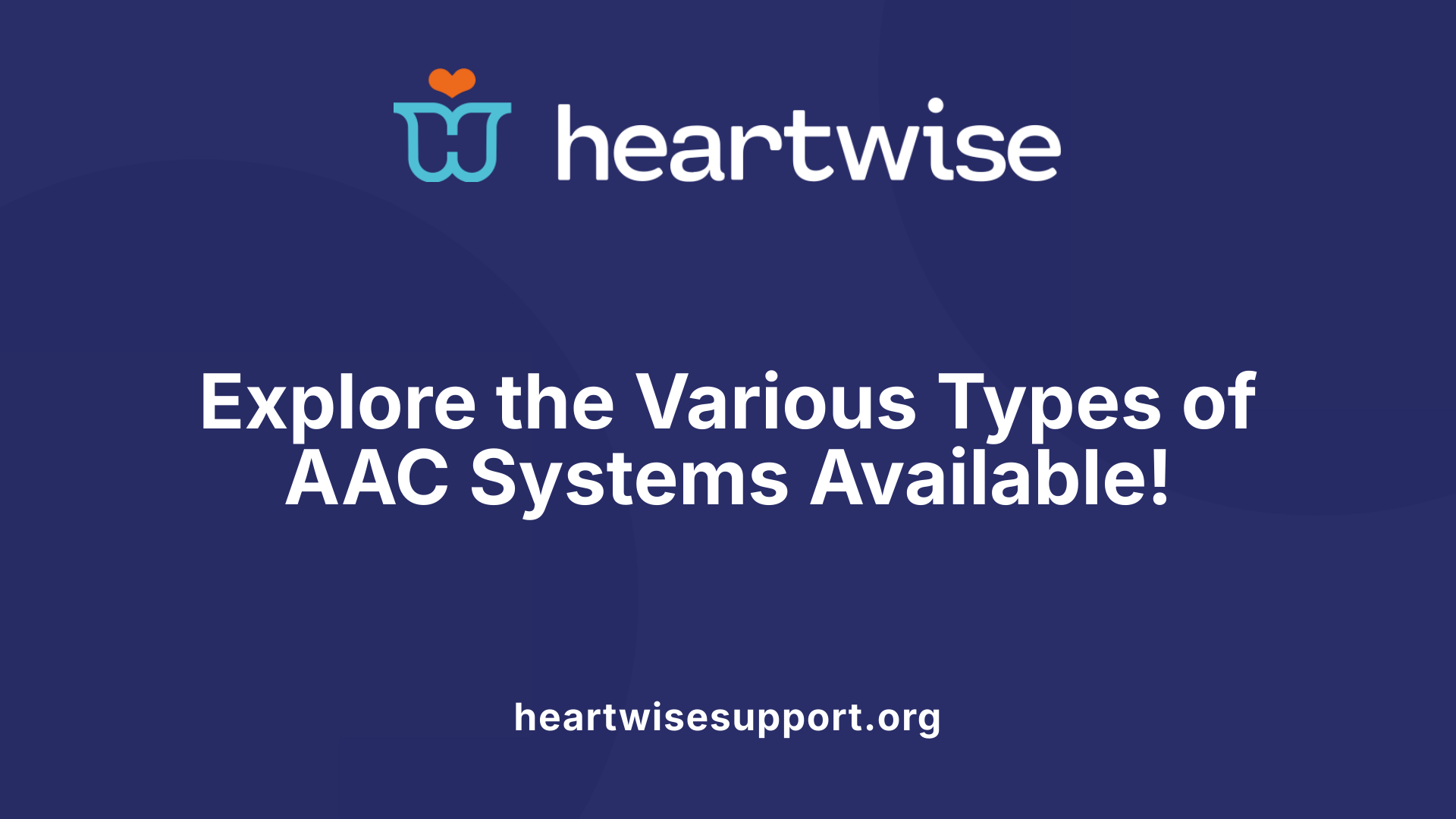Introduction to AAC and Skill Development
Augmentative and Alternative Communication (AAC) tools provide essential support for individuals with speech and language difficulties, enhancing their communication capabilities and overall skill development. These tools encompass a range of methods, from gestures and picture boards to advanced speech-generating devices, offering diverse opportunities for expression and interaction. In educational and therapeutic settings, understanding how to effectively implement AAC tools is crucial for facilitating communication and learning among students with complex communication needs.
Understanding the Types of AAC Systems

What types of AAC systems are available for enhancing communication skills?
There are several types of AAC systems available to enhance communication skills, classified into three main categories: no-tech, low-tech, and high-tech solutions.
No-tech AAC options include gestures, body language, and writing, which don't require any electronic devices. These methods can be particularly effective in everyday interactions.
Low-tech AAC devices involve more structured tools like picture boards, communication books, and spelling aids that can facilitate clearer exchanges without technology.
High-tech AAC devices are more advanced, using digital technologies. Examples include speech-generating devices like NovaChat and Via Pro by PRC-Saltillo, which offer customizable vocabulary options and user-friendly interfaces. Software applications, such as Tobii Dynavox's TD Snap, promote interactive communication through touch and eye-gaze activation, enhancing user engagement.
Speech-Language Pathologists play a crucial role in assessing individual needs and implementing the most suitable AAC system, ensuring effective communication enhancements tailored to each user's abilities.
Supporting AAC Implementation in Educational and Therapeutic Settings

How can educators and speech-language pathologists support the use of AAC tools?
Educators and speech-language pathologists (SLPs) play a vital role in effectively implementing AAC tools within educational and therapeutic settings. Tailoring instruction to match the user's language level is essential, as it helps meet the specific communication needs of individuals with Complex Communication Needs (CCN).
One of the foundational strategies is utilizing core vocabulary. Core vocabulary consists of the most frequently used words, allowing students to express a wide range of thoughts and needs efficiently. Moreover, integrating the SETT framework—assessing the Student, Environment, Tasks, and Tools—ensures that the AAC system aligns with the learner's context and daily communication requirements.
Ongoing assessment is also critical for tracking the changing communication needs of AAC users. This may involve continually adjusting interventions to ensure supports remain effective as students grow and develop.
Selecting appropriate vocabulary is another key aspect. A balanced AAC system should offer both core and fringe vocabulary, the latter being specialized words relevant to specific situations or interests. This diversity in vocabulary aids not only in functional communication but also enriches the user's ability to express themselves in various contexts.
In essence, by focusing on these strategies—customizing vocabulary, employing ongoing assessments, and following the SETT framework—educators and SLPs can significantly enhance the communication skills of AAC users, promoting greater independence and social participation in their daily lives.
Enhancing Communication Skills with AAC Devices

How can augmentative and alternative communication (AAC) devices effectively enhance communication skills for struggling learners?
Augmentative and alternative communication (AAC) devices greatly enhance communication skills for struggling learners by offering diverse methods for expressing thoughts and needs beyond spoken language. These tools, which can be low-tech options like Picture Exchange Communication Systems (PECS) or high-tech speech-generating devices, cater to each learner's individual needs.
For AAC to significantly impact communication skills, the device must be readily available across different settings—classrooms, playgrounds, and homes—and seamlessly integrated into daily activities and routines. This ensures that students can practice and utilize their AAC tools regularly.
A critical element for success is the consistent modeling of AAC use by adults, which helps children learn how to engage with these devices. Similar to verbal communication, adults should demonstrate the use of AAC during interactions, allowing children to observe and reflect on its application.
Additionally, incorporating naturalistic procedures such as responsive play and effective communication strategies nurtures the development of social communication skills. Utilizing prompting and cueing, along with expectant pauses, can further encourage learners to engage actively, thereby fostering their independence and confidence in communication.
| Strategies for Enhancing AAC Communication Skills | Benefits for Struggling Learners | Additional Insights |
|---|---|---|
| Utilize consistent modeling by adults | Increased engagement in communication | Essential for skill development |
| Embed AAC use in daily routines | Personalized vocabulary enhances interaction | Supports academic participation |
| Create communication temptations | Encourages active use of AAC tools | Facilitates peer interactions |
| Allow expectant pauses | Fosters independent communication | Promotes patience in interactions |
| Provide prompting and cueing | Develops confidence in utilizing AAC | Enhances overall literacy skills |
In essence, AAC devices are invaluable tools that can significantly improve communication capabilities, actively helping struggling learners express themselves and connect within their environments.
Skills Required for Effective AAC Use
What skills are needed to use AAC tools?
The skills needed to effectively use AAC (Augmentative and Alternative Communication) tools encompass a variety of competencies. Notably, there are no prerequisite skills required to begin using AAC, which makes it accessible to diverse users.
Core skills include:
- Understanding Symbols: Users should recognize and interpret different symbols, whether they are pictorial, written, or digital, which are fundamental to effective communication.
- Basic Motor Skills: These skills are essential for interacting with AAC devices, enabling users to navigate touchscreens or press buttons consistently.
- Cognitive Skills: Comprehending the communication process, including cause and effect, aids users in making meaningful connections through their AAC systems.
Personalization plays a critical role in AAC effectiveness. Systems tailored to individual users allow for a versatile vocabulary that extends beyond simple requests, fostering richer communication experiences.
To maximize proficiency, communication partners must model language consistently. This includes using expectant pauses, which gives users time to respond and reduces pressure. Overall, presuming competence is vital; AAC users should have immediate access to comprehensive systems without needing to prove their capability first.
Examining Examples of AAC Devices
What are some examples of augmentative and alternative communication devices?
Augmentative and alternative communication (AAC) devices come in a variety of forms, catering to the diverse needs of users with communication challenges. Low-tech options include tools like picture calendars and communication boards, which are straightforward and don’t rely on technology. These aids can enhance communication in everyday situations, allowing users to engage meaningfully with peers and educators.
In contrast, high-tech AAC devices comprise sophisticated tools designed for advanced communication. Examples include dedicated devices like the Tobii Dynavox and MegaBee Assisted Communication Tablet, which are specifically tailored for AAC. Additionally, popular AAC applications such as Proloquo2Go, TouchChat, and LetMeTalk transform standard tablets, like iPads or Android devices, into powerful communication tools.
Moreover, portable options, like the Pocket Go-Talk 5-Level Communication Device and GOTALK 9+, enable users to store numerous messages, enhancing their ability to converse. Tools such as talking buttons also support users with limited motor skills, improving their communication experience. Speech tablets, like Goally's AAC tablet, provide customizable settings to meet individual preferences, ensuring users can express themselves effectively.
The broad range of AAC devices emphasizes the importance of customization to meet each user's unique communication needs. This adaptability is crucial for fostering effective communication and enhancing language development across various contexts.
Best Practices for Integrating AAC in Educational Settings

How to Model AAC Use Effectively?
Modeling the use of AAC (Augmentative and Alternative Communication) is one of the most effective strategies teachers can employ. By using a student's AAC device during interactions, educators provide real-life examples of language usage. This not only demonstrates various communication methods but also familiarizes students with the vocabulary available to them. It’s crucial that teachers point to words on the AAC system regularly during discussions, enabling students to engage and practice in context, much like typical language learners.
How Can Routine Integration Enhance Learning?
Incorporating AAC into classroom routines significantly supports skill development. Regularly using modeling with familiar, routine language reinforces students’ understanding and usage of essential vocabulary. For instance, teachers can create scenarios that involve predictable language contexts—think morning greetings, classroom instructions, or daily schedule discussions. The repetition in these settings reinforces language acquisition and helps students use their AAC tools independently.
Additional Best Practices
- Provide Communication Temptations: Create situations that encourage students to communicate for materials or information they want.
- Expectant Pauses: Allow time for students to respond to prompts, fostering independence in using their AAC systems.
- Prompting Techniques: Use cues like pointing to words as students engage with their devices, supporting their learning without overwhelming them.
Implementing these practices creates an inclusive environment, promoting communication skills among all students.
Role of Research and Methodologies in AAC Implementation
Impact of AAC on Skill Development
Research has shown that Augmentative and Alternative Communication (AAC) tools significantly enhance language development, social interactions, and overall participation in classroom activities. Children who utilize AAC systems often demonstrate improved vocabulary and comprehension skills. Specifically, AAC strategies like speech-generating devices and visual supports can promote engagement, offering children methods to convey thoughts, needs, and ideas clearly.
Research Findings
Further investigations highlight that children using AAC experience stronger language growth outcomes when they have multiple communication opportunities and interact with peers. It's noted that 90% of children with complex communication needs do not receive appropriate educational tools, which underscores the necessity for tailored AAC interventions.
| Research Area | Finding | Implications for AAC Implementation |
|---|---|---|
| Language Development | AAC supports vocabulary enhancement | Use of AAC leads to improved literacy outcomes |
| Peer Interaction & Growth | Peer communication enhances AAC usage | Encourage inclusive peer activities in classrooms |
| Teacher Engagement | More teacher interaction correlates with language skills | Train teachers to utilize AAC effectively during lessons |
In conclusion, incorporating research-backed AAC methodologies significantly boosts communication skills, fostering both social and academic growth for students with communication challenges.
Benefits of AAC Tools for Various Age Groups
AAC for Children and Adults
Augmentative and alternative communication (AAC) tools provide essential support across various age groups, particularly for children with speech or language impairments. These tools, such as speech-generating devices, picture exchange systems, and communication boards, enable users to express thoughts, needs, and ideas more effectively.
For children, starting with AAC can significantly enhance early communication skills and promote social interactions. Conversely, adults also benefit, as AAC can assist in maintaining their independence and social engagement, particularly those recovering from strokes or facing degenerative diseases.
Skill Development Benefits
AAC tools facilitate not only speech but also overall language skill development. Research indicates that they can boost vocabulary acquisition, improve language structure understanding, and enhance cognitive skills such as problem-solving and memory retention. Users experience greater participation in classroom activities, leading to increased social skills and confidence. Moreover, tailored AAC systems can adapt as users' communication needs evolve, ensuring sustained support and engagement.
| Age Group | AAC Tool Examples | Main Benefits |
|---|---|---|
| Children | Speech-generating devices | Improved language skills, social interaction |
| Adults | Communication boards | Enhanced independence, social engagement |
Building a Supportive AAC Environment

Communication Partner Training
Successful implementation of AAC systems significantly depends on effective training for communication partners, including educators, family members, and peers. These individuals play a pivotal role in modeling AAC usage and responding appropriately to AAC users. By being trained, they can better support students in expressing their needs and actively participating in classroom interactions.
Moreover, training helps partners understand the unique capabilities of AAC users, promoting a more inclusive environment. This shared knowledge fosters confidence among both AAC users and their communication partners, enhancing overall communication outcomes.
School Culture and AAC
A positive school culture that embraces AAC is crucial for enhancing communication among students with complex communication needs. Collaboration among teachers, speech-language pathologists (SLPs), administrators, and families is essential for creating an environment where AAC is recognized and valued. Such collaboration can inform decisions regarding resource allocation and teaching strategies that uplift AAC usage.
To effectively embed AAC into the educational framework, adaptations in policies and practices may be necessary. A supportive school culture not only encourages communication through AAC but also nurtures learning and social interactions, benefitting all students involved.
Conclusion: Empowering Communication Through AAC
Augmentative and Alternative Communication (AAC) tools serve as invaluable assets in educational and therapeutic environments, providing individuals with the means to effectively express themselves and participate in meaningful interactions. By understanding the types of AAC systems available and the strategies for their use, educators, therapists, and families can foster environments that enhance communication and learning opportunities. As research and technology continue to evolve, the accessibility and implementation of AAC tools will increasingly empower individuals with communication difficulties, allowing them to develop crucial skills and improve their quality of life.
References
- 6 Ways to Motivate Students Who Use AAC Devices to Communicate
- Augmentative and Alternative Communication (AAC) - ASHA
- Learn AAC Guide - AssistiveWare
- Augmentative and Alternative Communication (AAC) - ASHA
- Exploring Classroom Factors and Augmentative and Alternative ...
- Support for AAC Use in Preschool, and Growth in Language Skills ...
- [PDF] Literacy Skill Development in Augmentative and Alternative ...
- Augmentative and alternative communication (AAC) - guidance
- An Introduction to Augmentative and Alternative Communication

.png)









